1. Sporophyte, dominant, photosynthetic and independent phase of plant represents
a) Haplontic
b) Diplontic
c) Diplohaplontic life cycle
d) Both (b) and (c)
Explanation: Diplontic
2. Diplontic life cycle is seen in
a) Angiosperms and gymnosperms
b) Spermatophytes
c) Both (a) and (b)
d) Pteridophyte
Explanation: Both (a) and (b)
3. When both the phases of life cycle are multicellular, i.e., haploid and diploid phases are more
than one celled
a) Life cycles are called haplodiplontic
b) They differ in the dominant phase
c) They are in pteridophytes and bryophytes
d) All of these
Explanation: All of these
4. In bryophytes
a) Dominant, diploid, multicellular sporophyte alters dominant with multicellular
gametophytes.
b) Dominant haploid multicellular gametophyte alters with diploid sporophyte.
c) The plant body shows diplontic life cycle.
d) The plant body shows haplontic life cycle.
Explanation: Dominant haploid multicellular gametophyte alters with diploid sporophyte.
5. Most of the alga show
a) Haplontic life cycle
b) Diplontic life cycle
c) Haplodiplontic life cycle
d) None of these
Explanation: Haplontic life cycle
6. Algae showing haplodiplontic life cycle are
a) Spirullina and spirogyra
b) Ectocarpus and polysiphonia
c) Kelps
d) Both (b) and (c)
Explanation: Both (b) and (c)
7. Which alga shows diplontic life cycle?
a) Chara
b) Fucus
c) Ectocarpus
d) Polysiphonia
Explanation: Fucus
8. How many organisms show haplodiplontic life cycle?
Sphagnum, Volvox, Ulothrix, Marchantia, Polytrichum, Selaginella, Pinus, Cedrus,
Ectocarpus, Polysiphonia
a) 8
b) 6
c) 7
d) 9
Explanation: 6
9. How many organisms show diplontic life cycle?
Selaginella, Equisetum, Cycas, Cedrus, Ectocarpus, Fucus, Sequoia
a) 7
b) 5
c) 4
d) 6
Explanation: 4
10. Which of the organisms show haplontic life cycle?
a) Chlamydomonas, volvox
b) Ectocarpus, polysiphonia
c) Fucus
d) All of these
Explanation: Chlamydomonas, volvox
11. In diplontic life cycle gametogenesis takes place by
a) Mitosis
b) Meiosis
c) Both (a) and (b)
d) Neither mitosis nor meiosis
Explanation: Meiosis
12. Gametogenesis in organism showing haplontic life cycle takes place in
a) Mitosis
b) Meiosis
c) Both (a) and (b)
d) Amitosis
Explanation: Mitosis
13. Identify a, b, c in diagram:
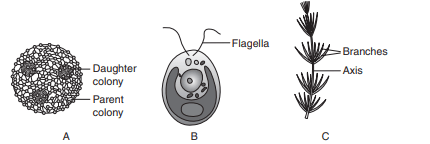
a) A– Volvox, B–Chlamydomonas, C–Chara
b) A–Chara, B–Volvox, C–Chlamydomonas
c) A–Chlamydomonas, B–Chara, C–Volvox
d) A–Chara, B–Chlamydomonas, C–Volvox
Explanation: A– Volvox, B–Chlamydomonas, C–Chara
14. Identify a, b, c in diagram:

a) A–Fucus, B–Laminaria, C–Dictyota
b) A–Laminaria, B–Dictyota, C–Fucus
c) A–Laminaria, B–Fucus, C–Dictyota
d) A–Dictyota, B–Fucus, C–Laminaria
Explanation: A–Laminaria, B–Fucus, C–Dictyota
15. Identify A and B:
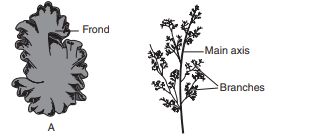
a) A–Porphyra, B–Laminaria
b) A–Polysiphonia, B–Porphyra
c) A–Porphyra, B–Polysiphonia
d) A–Volvox, B–Chara
Explanation: A–Porphyra, B–Polysiphonia
16. Identify the A, B, C and D shown in this figure?
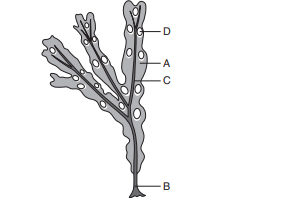
a) A–Holdfast, B–Air bladder, C–Midrib, D–Frond
b) A–Frond, B–Midrib, C–Air bladder, D–Holdfast
c) A–Air bladder, B–Midrib, C–Holdfast, D–Frondh
d) A–Frond, B–Holdfast, C–Midrib, D–Air bladder
Explanation: A–Frond, B–Holdfast, C–Midrib, D–Air bladder
17. Identify the A, B and C shown in this figure?
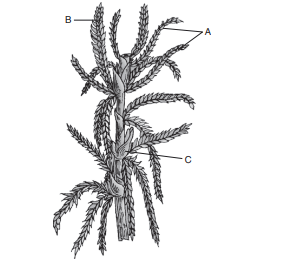
a) A–Branches, B–Antheridial branch, C–Archegonial branch
b) A–Antheridial branch, B–Branches, C–Archegonial branch
c) A–Branches, B–Archegonial branch, C–Antheridial branch
d) A–Archegonial branch, B–Archegonial branch, C–Branches
Explanation: A–Branches, B–Antheridial branch, C–Archegonial branch
18. What indicates A to E in the below figure?
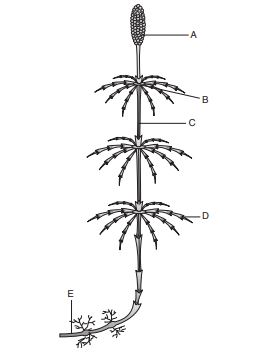
a) A–Node, B–Rhizome, C–Internode, D–Strobilus, E–Branch
b) A–Strobilus, B–Node, C–Internode, D–Branch, E–Rhizome
c) A–Branch, B–Internode, C–Strobilus, D–Node, E–Rhizome
d) A–Strobilus, B–Node, C–Branch, D–Internode, E–Rhizome
Explanation: A–Strobilus, B–Node, C–Internode, D–Branch, E–Rhizome
19. Identify the A, B and C shown in this figure?
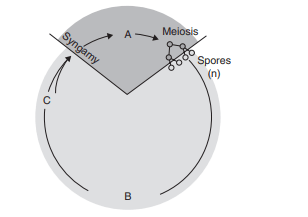
a) A–Gametophyte (n), B–Zygote (2n), C–Gametogenesis
b) A–Zygote (2n), B–Gametophyte (n), C–Gametogenesis
c) A–Zygote (2n), B–Gametogenesis, C–Gametophyte (n)
d) A–Gametogenesis, B–Zygote (2n), C–Gametophyte (n)
Explanation: A–Zygote (2n), B–Gametophyte (n), C–Gametogenesis
20. Identify the A, B and C.
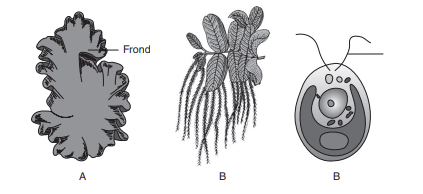
a) A–Salvinia, B–Chlamydomonas, C–Porphyra
b) A–Chlamydomonas, B–Porphyra, C–Salvinia
c) A–Porphyra, B–Salvinia, C–Chlamydomonas
d) A–Chlamydomonas, B–Salvinia, C–Porphyra
Explanation: A–Porphyra, B–Salvinia, C–Chlamydomonas